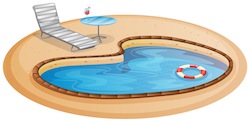Smart Homework: Can We Get Real?
Here’s the first of a several-part series on smart homework practices, adapted from Rick Wormeli’s seminal book about teaching in the middle grades, Day One & Beyond: Practical Matters for New Middle Level Teachers.
What’s most remarkable about Wormeli’s discussion? How relevant and contemporary it feels, a decade after he wrote it! The homework controversy continues, and Rick continues to offer great advice on this topic in workshops and presentations across North America. We’ve included some additional references for you at the article’s conclusion.

It’s ten minutes before the end of a hot and humid Wednesday in your classroom, and both you and your students already have more than enough personal and school-related commitments to fill the time between the end of school and bedtime that night. You announce the evening’s homework.
“Okay, listen up. Tonight you need to finish defining your 20 vocabulary words and wrap up your project that was assigned three weeks ago. The final version is due tomorrow. Make sure someone looks it over before you start the final version. Don’t forget that we have a quiz tomorrow as well. To prepare you for that, I’d like you to do pages 78–84 in the workbook. It’s a good review for what we learned today as well as earlier in the week. Do these carefully; I’ll be checking your work.”

The faint moan inside your own head may not be as audible as your students’, but it’s there, and the spark of dread that inspired it will soon transform into glowing resentment that will burn through your passion for teaching.
Opinions run strong
It doesn’t have to be this way. Homework can be one of the most renewing and exciting aspects of teaching middle school, but we have to be smart about its structure, assignment, and assessment.
Homework policies and practices press people’s buttons; opinions run strong. Every year some parents commented that I didn’t give enough homework and others said that I gave too much.
Teachers and schools are considered rigorous if they give a lot of homework, almost regardless of the type of homework that is given or the quality of the classroom instruction. Those who teach well but are light on homework are considered weak or not challenging enough.
What’s more, many middle school students pass or fail purely on whether or not they did their homework, not necessarily on whether or not they mastered concepts. With so much riding on homework, a clear examination of its purposes, management, and motivation is warranted.
Why do we have homework?
One of the big reasons we assign homework is for practice. Mastery takes practice and homework is the way students practice. Homework helps students reinforce clarified concepts. We assign homework to enable students to apply or extend the day’s learning outside of the classroom, one of the best ways to move information from working memory to long-term memory.

If homework is assigned to students before the concepts are clarified, however, then it does more harm than good. Learning acquired from practicing incorrectly is very hard to overcome. The brain loves to confabulate. It seeks wholeness, and when it has only a partial understanding of something, it draws facts and perspectives from other areas of the mind as well as pieces of fabricated information and inserts them into the “holes” of learning to make concepts appear whole.
Even worse, the brain will convince itself that this was the original learning all along. Enter the teacher, who has to discern what solid understanding the students have, convince them that their confabulations (i.e., their misconceptions) are wrong, and teach them the right learning.
What a tough situation! It takes far more time and energy to figure this out and reteach content than it does to teach content fully from the beginning, then have students practice it correctly. If students don’t have close to 100 percent mastery of the day’s learning, it’s best to assign no homework that evening, or at least to adjust the nature of the assignment.
Don’t worry about not appearing rigorous. Focus on successful student learning, not appearances. Homework given to keep students busy regardless of whether it clarifies, reinforces, or prepares students for learning is irresponsible.
Managing the homework load
There are many ways to make homework manageable. First, don’t overdo it for the sake of rigor. If the students get the practice or reinforcement by doing ten examples instead of 30, give them ten. Everyone procrastinates when the workload is heavy, even teachers facing a pile of papers. If the pile is thin, we tackle the task more readily because success doesn’t seem so far away.
Another way to shorten homework is to cut the amount that has to be written. Most middle school students can demonstrate a clear understanding of something in one good page of writing. We don’t need the four-page paper to have evidence of mastery.

Getting papers back in a timely manner means the students get feedback faster, too. Frequent feedback is a proven motivator. Young adolescents will put more thought into assignments if they are likely to get them returned in a day or three—as opposed to assignments they know they won’t see again for weeks.
Teachers are looking for deeper and more complex responses to learning. Homework for which the teacher or classmates give specific feedback to the student in a timely manner results in greater impact on learning (Marzano 2001). Homework without feedback or with delayed feedback results in almost no learning. And homework assignments are not well designed unless they include how the completed assignments will receive feedback in a timely manner.
Exciting homework? Why not?
Homework that is engaging is likely to be done. Break up routine homework with not-so-routine homework. Unique homework includes assignments that require students to interview family members or friends; incorporate artwork, music, drama, or media; and interact with content and skills in meaningful ways. Allowing students to respond via their strengths and interests is a sure way to get them engaged.

How about preparing pretend business letters for business CEOs using classmates’ names? Interviewing each other as experts to demonstrate primary resources? How about a poetic ode to classmate Jeremy’s pentagonal prism, describing its features (edges, vertices, faces)?
Another way to make homework motivating is to increase its complexity. Students are likely to do more thought-provoking homework. I know this sounds counterintuitive, but it works. Every time I increased the complexity of assignments, more students completed them. Instead of routine assignments that require students only to go through the motions of doing homework, try some of these:
▶ Design a flag that incorporates the suffragists’ goals in its symbols and pattern.
▶ How does this painting express the theme of passage?
▶ Identify the mistake in the student’s solution and what the student still needs to learn.

▶ Write a constitution for your underwater city that reflects the politics of ancient Rome.
▶ Sculpt (literally and symbolically) the meaning of each vocabulary term.
▶ Create twelve intelligent questions for which the answer is “chromosome.”
▶ Create a television PSA that persuades young adolescents to make good decisions regarding snacks after school.
▶ Create a six-panel comic strip portraying this historic event.
Prime the homework pump
Answering basic recall questions can make students feel like they are accomplishing a lot, but the assignments lose their luster quickly. The act of reading material and plucking answers from the text becomes drudgery. Prime the pump with assignments calling for higher thinking levels: comprehension, application, analysis, synthesis, and evaluation.
According to Frank Williams, there are eight levels of creative thought; the first four are cognitive, the last four are affective. All eight levels provide great stimuli for homework assignments. Here are some examples from Imogene Forte and Sandra Schurr’s book, Integrating Instruction in Science (1996):
Fluency – Think of the characteristics that distinguish a living thing from a nonliving thing. List as many of these characteristics as you can.
Flexibility – Devise a classification system for living things based on characteristics of living things that manifest differently in different kinds of organisms.
Originality – Write a description of life as if you had to explain it to a nonliving thing.
Elaboration – Explain how biologists rely on the methods and discoveries of scientists in other fields to do their work.

Complexity – Discuss the issues involved in the work of a scientist whose discoveries improve some lives, but whose work is based on experiments that harm other living things.
Curiosity – What questions would you like to ask a biologist in order to learn about a typical day in the life of a scientist?
Imagination – Write a brief imaginative account of Marcello Malpighi’s first view of the movement of blood through capillaries with a microscope.
Another way to engage students is through their reading material. Journalistic writing is a lot more engaging than encyclopedic writing. Such writing is a lot more fun to grade, too. Have students read articles from magazines and online sources about the content you are trying to teach.
Journalistic writing differs from encyclopedic writing in terms of voice and the reader’s engagement. The journalistic approach begs to be read; it begs to be read aloud, in fact. Asking students to write journalistically about a topic while incorporating an understanding of concepts is not only motivating, but rigorous and effective learning.
Once students read the journalistic version, they are hungry and primed for the “encyclopedic” version. Better yet, everything they read in the encyclopedic version now makes sense and has meaning. Their eyes don’t glaze over as they read; the knowledge is compelling.
“Go home and manipulate the information”

The most effective learning, however, occurs in the song’s creation. In the process of creating a rap song, students must identify the critical attributes of the concept they are exploring and try to teach it to others. As they say the phrases over and over, they memorize the facts and the information moves to their longterm memory. When students follow a beat, they can remember long passages that would rival Homer’s Iliad.
Regardless of your own comfort with the medium, take a chance and ask students to write raps, poems, lyrics, and stories that accurately express the content they have to master. With these assignments, working with a partner or in a group works well, students have fun, and they learn the material—three good reasons to incorporate them into your homework repertoire.
NEXT: Creating motivating homework assignments using a dozen guiding principles.
More Wormeli homework resources:
Grading homework (archived comments)
How Much Should Homework Count? (YouTube video)
Notes from a Homework Session with Rick Wormeli
ALSO SEE:
Part 2 – Smart Homework: 13 Ways to Make It Meaningful
Part 3 – Smart Homework: How to Manage & Assess It
________

His books include Meet Me in the Middle; Day One and Beyond; Fair Isn’t Always Equal: Assessment and Grading in the Differentiated Classroom; Differentiation: From Planning to Practice; Metaphors & Analogies: Power Tools for Teaching Any Subject, and Summarization in Any Subject. Also see: The Collected Writings (So Far) of Rick Wormeli: Crazy Good Stuff I Learned about Teaching Along the Way.
The 2nd edition of his bestselling book Fair Isn’t Always Equal (2018) is now available.































Thank you…I hope a lot of teachers read this, and also your archived comments on “grading” homework. Two years ago, I substantially changed what and how often I assign homework and I no longer take off points for mistakes as long as they are corrected when we go over the correct responses in class (as a language teacher, much of the practice has clear right/wrong answers for novice learners). My students’ rate of completion and willingness to do the practice activities and their ultimate proficiency have improved as a result!
This is the only way to do homework. I know many teachers that give homework on Monday, collect on Friday, and give stickers to the students for presenting or completing homework. I always wonder how do they know which student gets the concept or needs help. For some teachers it is a way to keep the students busy. Homework drives our teaching and informs us about students’ learning. It has to be checked every day with the students. It is a good practice, and a stepping stone to the next lesson. I know that some of my principals didn’t like the idea of homework, but I continued my homework policy every day because it helped my students to practice the new concepts, to better retain the given concepts, analyze, sharpen their critical thinking and become creative. Homework is not a busy work: cut and paste, color and fold. So I totally agree with this article.
Very enlightening!!! :0)